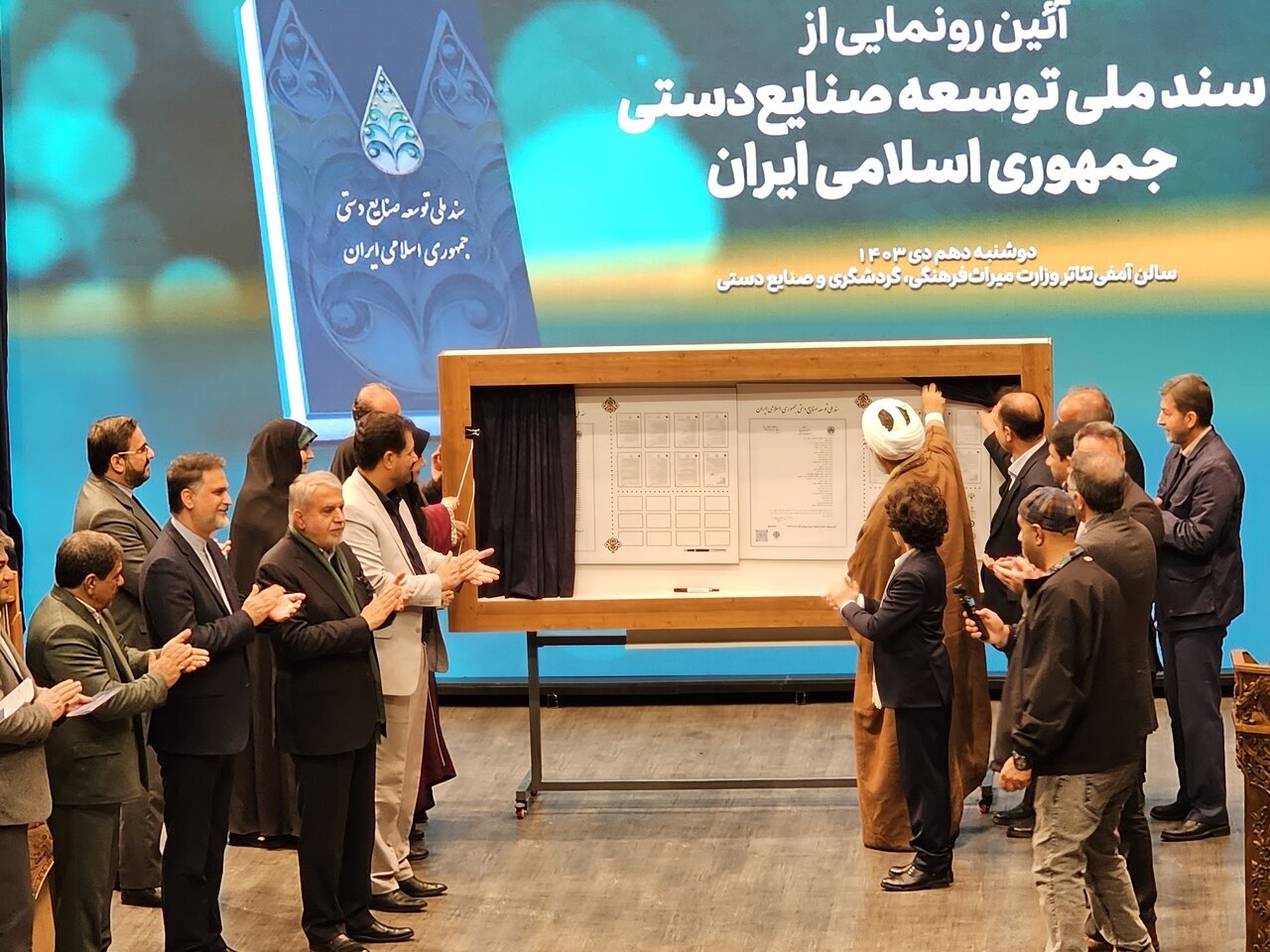National Document for Handicrafts Development unveiled

TEHRAN - The unveiling ceremony for the National Document for the Development of Handicrafts was held on Monday at the headquarters of the Ministry of Cultural Heritage, Tourism, and Handicrafts.
The event was attended by a number of high-ranking officials, members of the Iranian Parliament (Majlis), craftspeople, and media personnel. It featured remarks by Seyyed Reza Salehi-Amiri, Minister of Cultural Heritage, Tourism, and Handicrafts; Abdolkarim Hosseinzadeh, Vice President for Rural and Underserved Areas Development; Zahra Behrouz-Azar, Vice President for Women and Family Affairs; and Reza Alizadeh, Chair of the Parliament’s Industry Committee, among several others.
Development does not happen with oil wells
Highlighting the significance of handicrafts, Salehi-Amiri emphasized that handicrafts represent Iranian identity.
“If progress is to happen in the country, its path is through human and cultural development. Whether it’s carpets or other forms of art, they have a physical form, but it is their soul that portrays art and beauty. It is this art and creativity that keeps society alive and dynamic.”
Elsewhere in his remarks, the minister said that the pace of development in Iran accelerated with the discovery of oil wells, “but now we have not and will not achieve the goals of development through oil.”
“Over 100 years have passed since the discovery of oil in Masjed Soleyman. Development in Iran started with oil wells, but now we have not and will not reach the goals of development through oil.”
Implementation and future goals
Speaking at the ceremony, Maryam Jalali-Dehkordi, Deputy for Handicrafts, announced the formation of four working groups tasked with implementing the document’s provisions.
She expressed optimism about the transformative potential of these efforts.
Advocating for the handicrafts sector
Addressing the event, Hosseinzadeh highlighted the need for revitalizing opportunities in the handicrafts sector. “Despite holding the top position in handicraft diversity, our [country’s] share of the global market is only 300 million dollars,” he noted.
Hosseinzadeh advocated for regional cooperation with culturally aligned nations such as those that celebrate Nowruz (the Persian New Year) and suggested using the maximum advantage of economic diplomacy to promote Iranian handicrafts abroad.
Behrouz-Azar emphasized the significant role of women in this industry, stating that over 70% of the country’s handicraft producers are women. “Handicrafts are more than art; they are narratives of life in Iran, reflecting its diversity and cultural identity,” she remarked.
Behrouz-Azar also pledged support from her office to empower women artisans.
Alizadeh lauded the National Document as a well-researched initiative, emphasizing the need to address gaps such as the absence of national and global brands and the limited utility of many handicraft products. “This document provides clear directives for various agencies and paves the way for substantial improvements in the sector,” he said.
Another speaker at the event was Mehdi Jamalinejad, the governor-general of Isfahan province, who highlighted the province’s vibrant handicrafts ecosystem, with over 1,500 workshops and villages where every home functions as a workshop.
Jamalinejad called for institutional reforms and the establishment of a national branding system to enhance the global standing of Iranian handicrafts.
A call for the removal of bureaucratic barriers
Abdolhossein Khosrowpanah, Secretary of the Supreme Council of Cultural Revolution, underscored the spiritual and family-centered aspects of handicrafts.
He urged the removal of bureaucratic barriers and called on government agencies to support artisans by purchasing their products as official gifts. “This comprehensive document reflects the input of over a thousand experts and craftspeople. It must be complemented with legislative action and cultural dialogue,” he added.
A vision for the future
The National Document for the Development of Handicrafts is expected to address longstanding challenges in the sector and ensure the sustainability of this culturally significant industry.
The document was officially issued earlier on November 5 by President Masoud Pezeshkian as a pivotal step to bolster the country’s traditional arts and crafts sector.
The document is set to be communicated to a wide range of governmental bodies, including the Ministries of Cultural Heritage, Tourism, and Handicrafts; Economy; Foreign Affairs; Education; Agriculture; and Industry, among others. It also highlights the need for technological integration, urging adaptation to innovations such as artificial intelligence, blockchain, and the metaverse to ensure the sector remains competitive and relevant in a rapidly evolving global market.
Moreover, the document refers to a number of challenges and solutions on the path of its chosen goals. Despite its rich heritage and time-honored history, the handicrafts industry faces numerous challenges, including fragmented management, inadequate market access, and the absence of large-scale enterprises, part of its text reads.
Among the practical steps of the document are organizing training programs, facilitating exports, and establishing a national database for craft designs and artisans.
Currently, a selection of 13 cities and three villages in Iran have been registered by the World Council of Handicrafts as “world cities of handicrafts”.
AM
